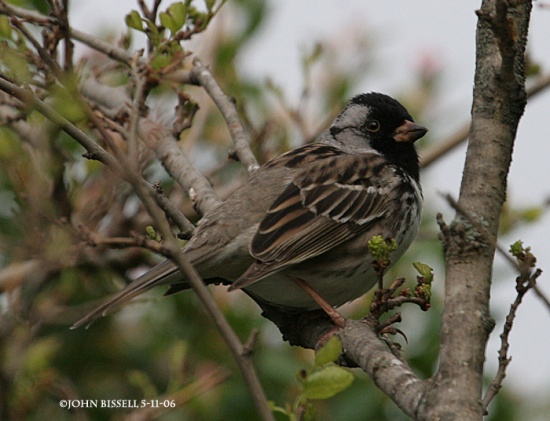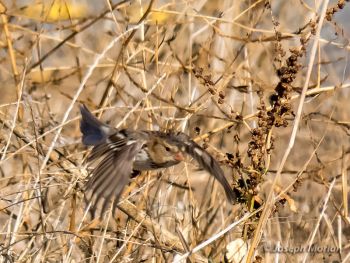- Zonotrichia querula
Identification

Photo © by Stanley Jones
Fort Worth Nature Center and Refuge, Tarrant County, Texas, USA, February 1980
The largest sparrow in North America, with length 16–19 cm (6¼-9½ in), Wingspan 26.5cm, weight 36gm.
In structure, this species resembles other members of the genus Zonotrichia with long tail and rather stout head and body.
Breeding
Distinctive plumage, with black crown, face, and throat. A thin black line extends behind the eye, widening as it curls behind the gray cheek patch. Supercilium and the sides of the neck are also ashy gray. The rump is solid gray, contrasting with boldly streaked wings and back. The belly is white.
Bill is entirely pink.
Non-breeding
Adults lose some of their gray coloration in winter, acquiring more brownish color on the face; throat sometimes shows white in the winter.
Immature in their first winter resemble dull winter adults, but show even more extensive brown on their faces and crowns (very little black), and more purely white on their throats.
Distribution
They are the only songbird whose breeding range is restricted to Canada. They are most commonly observed on their wintering grounds in the plains of the south-central United States. Midwest from Kansas south through Texas. Casual sightings throughout the U.S.. They breed in the far northern territories of Canada.
Taxonomy
This is a monotypic species[1].
Habitat
Found at borders of forest-tundra, in areas with white spruce.
Behaviour
A distinctive ground-nesting songbird, they are the largest sparrows in North America besides towhees.
Diet
Their main summer diet consists of invertebrates and pine needles. In the winter they eat seeds and fruit.
They forage on or close to the ground.
Vocalisation
Song: is a series of one to three high, clear whistles on a single pitch.
Call: one common call note is a loud 'chip'; alarm note is somewhat harsher.
References
- Clements, J. F., T. S. Schulenberg, M. J. Iliff, D. Roberson, T. A. Fredericks, B. L. Sullivan, and C. L. Wood. 2016. The eBird/Clements checklist of birds of the world: v2016, with updates to August 2016. Downloaded from http://www.birds.cornell.edu/clementschecklist/download/
- Handbook of the Birds of the World Alive (retrieved April 2017)
Recommended Citation
- BirdForum Opus contributors. (2025) Harris's Sparrow. In: BirdForum, the forum for wild birds and birding. Retrieved 11 May 2025 from https://www.birdforum.net/opus/Harris%27s_Sparrow
External Links
GSearch checked for 2020 platform.1






